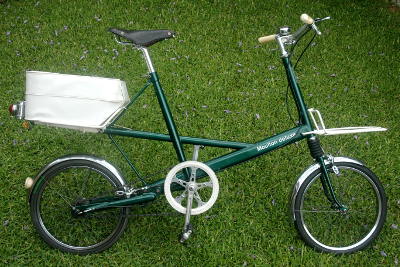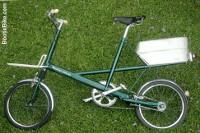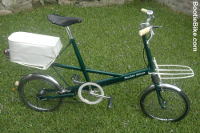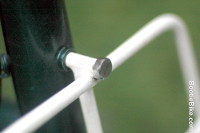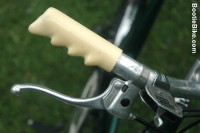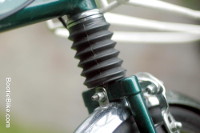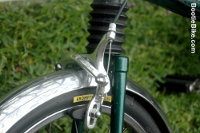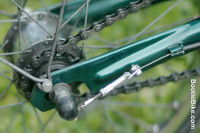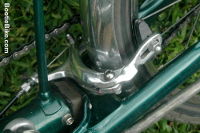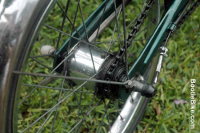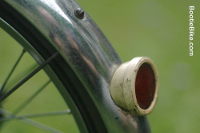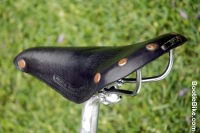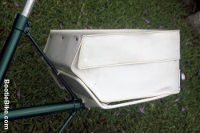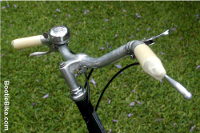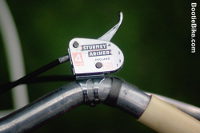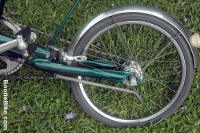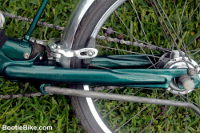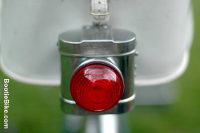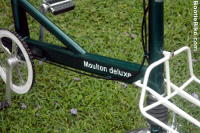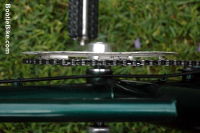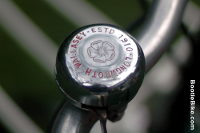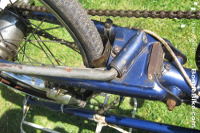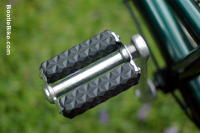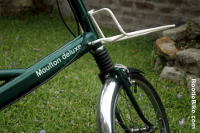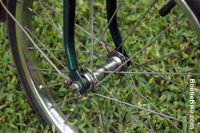1960s 'F frame' Moulton
The one that started it all
This is the original 'F frame' Moulton – the bicycle that broke the mould of conventional bicycle design. It's what happens when the foremost authority in automotive rubber suspension systems sets out to reinvent the bicycle. That authority was Alex Moulton (1920 – 2012). Famous for his work on car suspension while still in his thirties, he turned his hand to bicycles as well and stuck with it for the rest of his life. However, the significance of his bike goes beyond it being just a machine, as it was also an icon of the ‘swinging 60s’,  alongside the mini skirt and the Mini (car). Perhaps the ‘mini’ wheels had something to do with it.
alongside the mini skirt and the Mini (car). Perhaps the ‘mini’ wheels had something to do with it.
And those wheels are small. When I saw my first Moulton bike I couldn't help but be stunned by their size. I’d seen plenty of pictures of course, but somehow it just isn't adequately conveyed by two dimensional imagery. But it wasn't long before it seemed only natural for this bike to have such small wheels – the starting point for a clean sheet design. And what a design – practical, beautiful, ageless. Did I mention that I like the Moulton?
natural for this bike to have such small wheels – the starting point for a clean sheet design. And what a design – practical, beautiful, ageless. Did I mention that I like the Moulton?
The wheels are small, but the bike is long. The early Moultons have a wheelbase about 100mm longer than is normal, in part I think to prevent them being seen as a 'kid's bike', and also to help dispel any lingering doubts about the stability of a bike with such small wheels. Whatever, the length gives the proportions that lend the bike its distinctive yet timeless Dan Dare looks.
The Series 2 and 3
The Moulton you see here is a 'Series 2', in Moulton parlance. Many running changes had been made since production began in late '62, introducing small improvements and ironing out various bugs, major and minor. One change was a new sidestand. The Series 1 sidestand may have been effective, but one look at the Series 2 version (discretely mounted out of the way) has you wondering why it wasn't like that in the first place. But probably the most important change was a stronger swingarm, as the original design had a tendency to fracture. 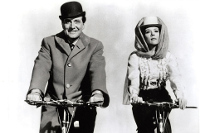 Anyway, combine all the running changes with some cost-cutting measures in response to falling sales and you have the definitive ('New Look') Series 2 of 1965.
Anyway, combine all the running changes with some cost-cutting measures in response to falling sales and you have the definitive ('New Look') Series 2 of 1965.
Falling sales? That's what happened with the emergence of lookalike competition. For a while the Moulton bike sold very well indeed, but that changed in mid-1965 with the release of the Raleigh RSW. The Raleigh was a bit smaller than the Moulton, and it had fat, soft tyres instead of suspension. In fact it could be argued the RSW was hardly a worthy competitor at all; but it had its charms, looked the part and was available at just about any High Street bike shop. The young Moulton firm, the one that once couldn’t keep up with demand, was suddenly in trouble, so Raleigh took it over and itself began making 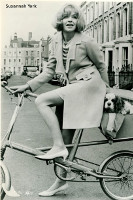 the Moulton bike.
the Moulton bike.
Raleigh didn't change it much, basically just substituting a few of its home-grown bits (including their uniquely threaded bottom bracket, which is difficult to upgrade) for some of the generic ones previously used. It fiddled with the range, changed the model names and got on with making the bikes.
Alex Moulton was kept on as a consultant. This gave him the opportunity to have another go at redesigning the swingarm, and the result was the Series 3, the last of the original 'F frame' Moultons. It's been said the lighter weight and shorter wheelbase of the Series 3 lent it more 'sports' potential than the earlier bikes, but if that were so it was certainly lost on the Raleigh mothership, as the Series 3 was as heavy and slow as only they could make it. (Moulton returned in 1983, proudly independent, with his more upmarket 'AM' series bikes. Whether he knew it or not at the time I don't know, but I think the design of the Series 3 swingarm showed where he was headed…)
On the road
This, the mainstream 'deluxe' version of the original Moulton, is big, comfortable and relaxed. There were a few nimble sports versions made, and even a separable, 'Stowaway' model, but most were everyday utility bikes like this, basically the Raleigh Sports re-imagined. The ‘Deluxe’ boasts, amongst other things, chrome plated mudguards and a four speed Sturmey Archer ‘FW’ geared hub, rather than the standard model’s painted guards and three speed hub.
The Moulton might be a humble everyday bike, but not as you know it, and the difference is obvious on the first ride. The suspension was not designed to provide a Rolls Royce ride, nor for jumping kerbs or offroading;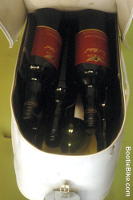 rather it was there to compensate for the bumpy ride that comes with small wheels. The fact that it actually improved the ride (and control on rough surfaces) was just a bonus.
rather it was there to compensate for the bumpy ride that comes with small wheels. The fact that it actually improved the ride (and control on rough surfaces) was just a bonus.
I run modern tyres (now the discontinued Brompton 'yellow' – I think Brompton 'greens' are too harsh) with much more pressure than the originals would have had (say 60psi), which reduces rolling resistance at the cost of some comfort. As it is, it still has a great ride and it offers reasonably brisk progress, without rewarding hurriedness. As for the improved control, that takes the 'white knuckles' out of sudden encounters with a rough patch of road at speed or mid-corner. The sort of thing that would have one hanging on for dear life on a normal bike is much less likely to unsettle a Moulton.
The four speed hub
The Sturmey Archer FW four speed hub is a pleasure to use. The extra gear allowed the designers to widen the range (190% vs 177% for the three speed) while narrowing the gap between each gear. This is very nice compared to the more common three speed model, and it adds greatly to the easy going nature of the bike. 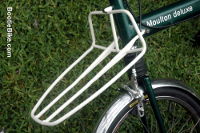 But there is one qualification; selecting first gear can sometimes be difficult for the uninitiated. First gear is selected against strong spring pressure, so it requires a bit of finger effort, and the gears involved can be reluctant to mesh. A degree of mechanical sensitivity can go a long way here, and with that and a little practice one's finger learns to ‘feel’ the lever into first; a mark of the Sturmey cognoscenti! The FW hub, which was produced from 1945 until the late 60s, was the mechanical basis for the twin-cable five speed hubs that followed it (see box below).
But there is one qualification; selecting first gear can sometimes be difficult for the uninitiated. First gear is selected against strong spring pressure, so it requires a bit of finger effort, and the gears involved can be reluctant to mesh. A degree of mechanical sensitivity can go a long way here, and with that and a little practice one's finger learns to ‘feel’ the lever into first; a mark of the Sturmey cognoscenti! The FW hub, which was produced from 1945 until the late 60s, was the mechanical basis for the twin-cable five speed hubs that followed it (see box below).
Quality woes
It has to be said that the early Moultons weren't always well made. Booming sales led Alex Moulton to farm out production to BMC, the folk who made Minis and Austin/Morris 1100s etc. He already had a close relationship with that firm, as he had designed the innovative rubber-based suspension systems for their newer models (including the Mini – fancy having a hand in two 60s icons!) and it's not hard to imagine the deal being done over a handshake at the club. In any case, it turned out that BMC wasn’t very good at making bicycles, so he probably regretted it. (Period photos of the production line show unsuspecting Moultons being assembled by people who look very young, which is perhaps a clue. Maybe the BMC trainees/apprentices cut their teeth on bike assembly before being let loose on the car production lines?)
The common wisdom is that the quality woes were largely sorted by the time of the Series 2, but my own experience suggests otherwise. My late 1965 Moulton Deluxe tore in half as I rode it, gently sinking beneath me like a worn out office chair. The bike you see here is an amalgam of the original forks and swingarm, and a frame kindly provided by Moulton Preservation. (Big thank you to Michael Woolf and Moulton Preservation – a non-profit group dedicated to providing much-needed bits to keep old Moultons on the road – support them!)
Changes to this bike
Apart from the minor matter of a new frame, our featured bike has been subtly modified, I hope without sacrificing its original character. The straight Series 2 swingarm; strong and heavy, has been tidied up a little. The Deluxe model came equipped with lighting courtesy of a swingarm-mounted generator. Leaving it there would be a must for the purist restorers, but on this bike it was the first thing to go. That bit was easy; not so removing the chunky eyesore of a mounting bracket that remained. Another petty eyesore was a clamped-on cable stop (for the gear cable), which I’ve replaced with a brazed-on version. Why couldn't the factory do that?
Being a Series 2, it originally came with steel (i.e. cheaper than alloy) bits and pieces, such as the handlebars and brakes.  Now it sports period alloy bars, stem and brake levers, and new dual-pivot alloy brake calipers. I've also replaced the original bottom bracket with a sealed unit and fitted an alloy crankset (with the original chainguard screwed on to it).
Now it sports period alloy bars, stem and brake levers, and new dual-pivot alloy brake calipers. I've also replaced the original bottom bracket with a sealed unit and fitted an alloy crankset (with the original chainguard screwed on to it).
The chrome plated steel wheels remain – they're too nice to hide, and they maintain the period look, even if this rules out wet weather use. (Caliper brakes don't work very well on steel wheels. No, I don't know how they got by back in the day when most bikes had steel wheels.) Cheapie 'Union' rubber block pedals do the job for now while looking the part, with the bonus of being tad lighter than the tatty originals (and they look an awful lot like those originally supplied on some 'Mini' Moultons 50 years ago).
Other details include the copper-riveted Brooks saddle, which suits the bike perfectly. I've also used the Bootiebike cable guides™ to replace the remains of the original cable guides. Lastly, the rear suspension block is now secured in the frame by loctited machine screws rather than sheet metal screws that come loose all the time.
Practicality
The result of all the above is improved function, a cleaner appearance and a useful weight reduction. It's still a bit heavy by contemporary standards, but then it's more fully equipped than most contemporary bikes as well, with an internal gear hub, mudguards, a sidestand and a carry rack at each end. The racks don't add much as they weigh next to nothing (tubular steel?), a nice quality touch, and a contrast to the (rear only) rack of the Raleigh RSW, which is definitely made of solid steel. Both racks are low mounted, courtesy of the small wheels, so the load is carried low; a loaded Moulton is therefore much less top heavy than a similarly loaded conventional bike. What's more, the front rack is frame mounted, so the steering remains unaffected by the load.
So here ends my spiel on what could be the most original bike of the Twentieth Century. More efficient than its contemporaries, yet more practical. Unrivalled comfort and control, and the convenience of a step-through frame. And timeless style. For these and more the Moulton is Bootiebike's first choice for everyday duties. It's not without its drawbacks – being much more complicated than a normal bike, there is plenty to go wrong, and a rebuild is not to be rushed. Yet once sorted the results are more than satisfying. In short, a vintage bike without peer.
Further reading
The Moulton Mini; the smaller Moulton, made to compete with the Raleigh RSW
About small wheelers (i.e. why this small wheeler madness?)


